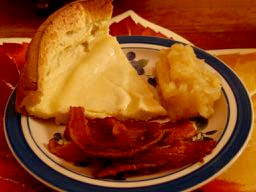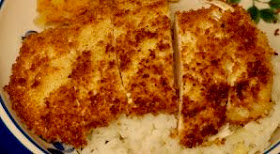6 December 2017
Japanese Milk Bread
Recipe from Bread Illustrated, 2016, p.94
I have been trying different recipes for white sandwich bread over the last year or two. This is another, from the chapter on sandwich breads from the America's Test Kitchen book, Bread Illustrated. It uses a technique, tangzhong, that worked very well in the Test Kitchen's recipe for fluffy dinner rolls which I've written about already.
This bread took four hours to make, before cooling, but most of this time is hands off. The recipe includes two unique features. First is the use of tangzhong, a paste, with a consistency like pudding, made from flour and warm water. This incorporates additional water into the dough without making it difficult to shape leading to a more tender crumb. The shaping method is also special: the dough is rolled into a thin sheet and then rolled into two tight rolls that are then baked in a standard loaf pan. The dough bakes into tender, feathery sheets. The dough is enriched with milk, butter, and an egg.
This is good sandwich bread! For the time being, at least, this will be my go-to recipe for making a white sandwich bread. I will continue trying other recipes but I could happily stop here in my search. It has a great texture and flavor and keeps very well. It takes a little longer to make but the wait is worthwhile, especially since most of the waiting time is just that, waiting, rather than working.
10 December 2017
Senate Navy Bean Soup
Recipe from Cook's Country, October 2014
I have long been searching for a good bean soup recipe, without notable success. I still buy Campbell's condensed bean with bacon soup, one of my favorites from childhood. I had read about Senate Navy Bean soup, and I had maybe even tried a version of it a long time ago. But I didn't think the Test Kitchen had a recipe until I am across this one recently.
The soup is quite simple with only a few ingredients. It took a little over two hours to prepare, not counting the time the beans were soaking, but much of this time is for the soup to simmer unattended. Navy beans are hard to find so I used "small white beans" which, so far as I can tell, are very similar and maybe the same thing. These are soaked in salty water over night. In a Dutch oven, onion, celery, and salt are cooked in oil to soften the vegetables, some garlic is added, and this mixture is set aside. Water, ham hocks, and whole cloves are simmered for 45 minutes. Potatoes and the onion mixture are added and cooked until the potatoes are tender. The ham hocks are removed and the mixture in the Dutch oven is partially mashed with a potato masher. The meat is removed from the hocks and added into the soup. Finally, a little vinegar is added to the soup.
The final soup of good, not great but quite good. Diane had seconds, which is a good sign. Some of the meat was tough; I couldn't shred it with forks but had to use a knife to cut it. My initial impression was that it was salty but I think that was wrong. After some additional sampling I think I was fooled by the vinegar. The soup keeps well, which is good because there is a lot of it for just the two of us. It is worth making again.
17 December 2017
Spaghetti and Meatballs
Recipe from America's Test Kitchen, Season 2
It has been a while since we had a pasta dish and even longer since we had classic spaghetti and meatballs. We usually have spaghetti with a meat sauce or a marina sauce without meatballs. Our most recent spaghetti used a meatless meat sauce because our daughter and boyfriend, who are vegan, were visiting. I've only made meatballs a few times, so I went searching on the ATK web site for a recipe and chose one from many years ago.
According to the recipe it can be "on the table in under an hour". I didn't quite make it, I needed 75 minutes, but if I had started the pasta sooner it would have been close to an hour. There is nothing particularly complicated about the recipe. The meatballs are made by mixing together ground beef, a buttermilk/white bread panade (I used buttermilk that had been frozen), Parmesan cheese, parsley, egg yolk, garlic, salt, and pepper. I used 100% ground beef rather than the 3:1 beef:pork mixture, because what do you do with ¾-pound of leftover ground pork? I used a #24 disher to portion the meat mixture resulting in 13 meatballs. These were flat on one side and I rounded them off before putting them in a ¼-inch layer of hot oil to fry. The sauce is simple: crushed tomatoes, garlic, and basil plus the fond from the meatballs.
This recipe made for a nice dinner. Actually three nice dinners for the two of us. The meatballs are very tender with a lot of flavor. The sauce was good but, by design, very simple and with a good texture that clung to the pasta. I wasn't sure how tightly to pack "¼ cup grated Parmesan cheese" so that is a possible variable between my meatballs and what was intended. The recipe also did not specify how fatty the ground beef should be. The meatballs were perhaps a little too tender, they tended to fall apart. There was also the problem of discarding over 1½ cups of dirty frying oil. I would make this recipe again, though it would be nice if the meatballs held together a little better and if the sauce had more flavor.
According to the recipe it can be "on the table in under an hour". I didn't quite make it, I needed 75 minutes, but if I had started the pasta sooner it would have been close to an hour. There is nothing particularly complicated about the recipe. The meatballs are made by mixing together ground beef, a buttermilk/white bread panade (I used buttermilk that had been frozen), Parmesan cheese, parsley, egg yolk, garlic, salt, and pepper. I used 100% ground beef rather than the 3:1 beef:pork mixture, because what do you do with ¾-pound of leftover ground pork? I used a #24 disher to portion the meat mixture resulting in 13 meatballs. These were flat on one side and I rounded them off before putting them in a ¼-inch layer of hot oil to fry. The sauce is simple: crushed tomatoes, garlic, and basil plus the fond from the meatballs.
This recipe made for a nice dinner. Actually three nice dinners for the two of us. The meatballs are very tender with a lot of flavor. The sauce was good but, by design, very simple and with a good texture that clung to the pasta. I wasn't sure how tightly to pack "¼ cup grated Parmesan cheese" so that is a possible variable between my meatballs and what was intended. The recipe also did not specify how fatty the ground beef should be. The meatballs were perhaps a little too tender, they tended to fall apart. There was also the problem of discarding over 1½ cups of dirty frying oil. I would make this recipe again, though it would be nice if the meatballs held together a little better and if the sauce had more flavor.






















































